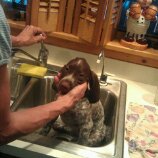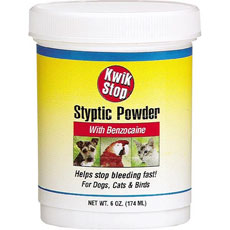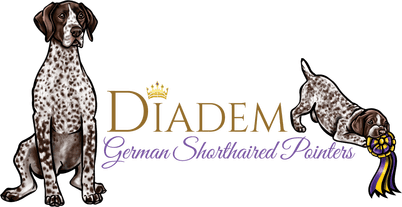Grooming Your GSP

Thank Goodness GSP’s are wash and wear dogs!! No long coats to deal with!
However, they will still need grooming. The Zoom groom is good at removing
loose coat.....this one is a rubber brush with conical bristles.... it gives a
nice massage and many dogs love it. The Zoom Groom also works great in the
bathtub for rubbing in the shampoo and working up a nice lather.
You want to handle paws often, as you will need to trim their nails
approximately every 2-4 weeks. For nail trimming, you will want to buy a trimmer for
large dogs. The large pliers’ type is the best, and I recommend purchasing this
style. I do not recommend Resco (guillotine) style trimmers, as they tend to
split the nails.
However, they will still need grooming. The Zoom groom is good at removing
loose coat.....this one is a rubber brush with conical bristles.... it gives a
nice massage and many dogs love it. The Zoom Groom also works great in the
bathtub for rubbing in the shampoo and working up a nice lather.
You want to handle paws often, as you will need to trim their nails
approximately every 2-4 weeks. For nail trimming, you will want to buy a trimmer for
large dogs. The large pliers’ type is the best, and I recommend purchasing this
style. I do not recommend Resco (guillotine) style trimmers, as they tend to
split the nails.

You will also need some "Kwik Stop" just in case you cut too close. Never trim
nails unless you have some Kwik Stop by your side (Cornstarch can also be used, but the Kwik Stop works much better!). Nails bleed a lot. If you do trim too close, do not make a big deal out of it. Calmly apply the Kwik Stop and go onto the next nail. I am sure it hurts some when we do this, but sometimes it just happens, and they recover very quickly. As in, as soon as you are finished and let them down off the table! I see dogs regularly that strongly object to having their nails trimmed and I have to either muzzle them, or refer them to a vet. This is pure silliness! Work on this care of your dogs feet is very important. Nails that are not trimmed can be injured, requiring a trip to the vet that could be costly, not to mention painful for the dog. If you don't feel
comfortable trimming the nails yourself, then pop into the local groomers or
vets for a nail trim on a regular basis.
When bathing, use a good quality mild shampoo that is sold for people, I do
not recommend the doggie shampoo purchased from discount stores! However, there
are excellent dog shampoo’s that can be purchased from dog supply catalogues or
dog shows. Puppies get dirty fast and bathing them when they are young is easy
and part of the learning experience. Puppies can be bathed in the kitchen sink for the first month. Puppy coats dry fast. However, you want to make sure your puppy is dried well and does not catch a chill. This is a great
time for some crate time with a towel to play with, followed by a trip outside
when he is dry and a playful brushing. Before bathing, stuff a cotton ball (or
part of one, you want a nice tight fit!) in each ear to help keep out water,
then wet down the entire coat. Never put shampoo directly on the coat. Use a
squeeze bottle and a couple ounces of shampoo diluted in water to apply to your
already wet puppy.
Make sure you scrub every square inch of the dog...this includes the head
(careful to avoid soap in the eyes!) face and ears, between the toes, in the
armpits, under the tail. It is very important you get all the shampoo rinsed
out, or you will have a puppy with flaky skin. Rinse until you are sure you
removed all the shampoo, and then rinse thoroughly one more time! We call
bathing a dog, giving the dog a "bath". Actually, it's giving the dog a shower..
I never fill a bath tub with water and "bathe" a dog in standing water. You
really need some type of hand-held shower sprayer to rinse the dog
effectively....a bucket just won't do a thorough job.
How often to bath? As often as your dog needs it! Even weekly baths are okay
as long as you use a top-quality mild shampoo with conditioners. You can always
do just a plain water rinse-down in between baths to freshen up. And
most of the dirt and mud will fall off the dog anyways after it dries.
Ears. Your dogs ears must be kept clean and dry. GSP’s can be prone to ear
infections, mostly due to moist conditions related to the drop ear flaps. If
your puppy's ears smell foul, consult your vet. I clean ears every other week,
but check them weekly. I only use real cotton balls, not cosmetic puffs. The
puffs have fibers that irritate the ear. You can use ear cleaners that you
purchase at a pet store for mega bucks, or you can make your own equally as good
ear cleaner for next to nothing: Mix 50% apple cider vinegar and 50% rubbing
alcohol.
The alcohol dries the ear canal and the vinegar changes the pH balance in the
ear preventing yeast growth. 99.9% of ear infections in GSP’s are yeast
infections because the ears are a warm and moist place for yeast to grow. Please
understand this is a preventative only, not a cure for yeast infections. If you
have problems with the ears, do not assume anything. Take your dog to the vet.
Careful using Q-Tips to clean ears, even though it's extremely hard to damage
the ear drum due to the construction of the canal. Q-tips can push wax or
objects down into the ear, hence requiring a vet visit. I flood the ear with
cleaner and massage the ear canal, then clean out with a cotton ball. This helps
expel rather than force things down further. Carefully cleaning afterwards
between the ear folds with a Q tip may be okay, but don't stick it where you
can't see!
nails unless you have some Kwik Stop by your side (Cornstarch can also be used, but the Kwik Stop works much better!). Nails bleed a lot. If you do trim too close, do not make a big deal out of it. Calmly apply the Kwik Stop and go onto the next nail. I am sure it hurts some when we do this, but sometimes it just happens, and they recover very quickly. As in, as soon as you are finished and let them down off the table! I see dogs regularly that strongly object to having their nails trimmed and I have to either muzzle them, or refer them to a vet. This is pure silliness! Work on this care of your dogs feet is very important. Nails that are not trimmed can be injured, requiring a trip to the vet that could be costly, not to mention painful for the dog. If you don't feel
comfortable trimming the nails yourself, then pop into the local groomers or
vets for a nail trim on a regular basis.
When bathing, use a good quality mild shampoo that is sold for people, I do
not recommend the doggie shampoo purchased from discount stores! However, there
are excellent dog shampoo’s that can be purchased from dog supply catalogues or
dog shows. Puppies get dirty fast and bathing them when they are young is easy
and part of the learning experience. Puppies can be bathed in the kitchen sink for the first month. Puppy coats dry fast. However, you want to make sure your puppy is dried well and does not catch a chill. This is a great
time for some crate time with a towel to play with, followed by a trip outside
when he is dry and a playful brushing. Before bathing, stuff a cotton ball (or
part of one, you want a nice tight fit!) in each ear to help keep out water,
then wet down the entire coat. Never put shampoo directly on the coat. Use a
squeeze bottle and a couple ounces of shampoo diluted in water to apply to your
already wet puppy.
Make sure you scrub every square inch of the dog...this includes the head
(careful to avoid soap in the eyes!) face and ears, between the toes, in the
armpits, under the tail. It is very important you get all the shampoo rinsed
out, or you will have a puppy with flaky skin. Rinse until you are sure you
removed all the shampoo, and then rinse thoroughly one more time! We call
bathing a dog, giving the dog a "bath". Actually, it's giving the dog a shower..
I never fill a bath tub with water and "bathe" a dog in standing water. You
really need some type of hand-held shower sprayer to rinse the dog
effectively....a bucket just won't do a thorough job.
How often to bath? As often as your dog needs it! Even weekly baths are okay
as long as you use a top-quality mild shampoo with conditioners. You can always
do just a plain water rinse-down in between baths to freshen up. And
most of the dirt and mud will fall off the dog anyways after it dries.
Ears. Your dogs ears must be kept clean and dry. GSP’s can be prone to ear
infections, mostly due to moist conditions related to the drop ear flaps. If
your puppy's ears smell foul, consult your vet. I clean ears every other week,
but check them weekly. I only use real cotton balls, not cosmetic puffs. The
puffs have fibers that irritate the ear. You can use ear cleaners that you
purchase at a pet store for mega bucks, or you can make your own equally as good
ear cleaner for next to nothing: Mix 50% apple cider vinegar and 50% rubbing
alcohol.
The alcohol dries the ear canal and the vinegar changes the pH balance in the
ear preventing yeast growth. 99.9% of ear infections in GSP’s are yeast
infections because the ears are a warm and moist place for yeast to grow. Please
understand this is a preventative only, not a cure for yeast infections. If you
have problems with the ears, do not assume anything. Take your dog to the vet.
Careful using Q-Tips to clean ears, even though it's extremely hard to damage
the ear drum due to the construction of the canal. Q-tips can push wax or
objects down into the ear, hence requiring a vet visit. I flood the ear with
cleaner and massage the ear canal, then clean out with a cotton ball. This helps
expel rather than force things down further. Carefully cleaning afterwards
between the ear folds with a Q tip may be okay, but don't stick it where you
can't see!

